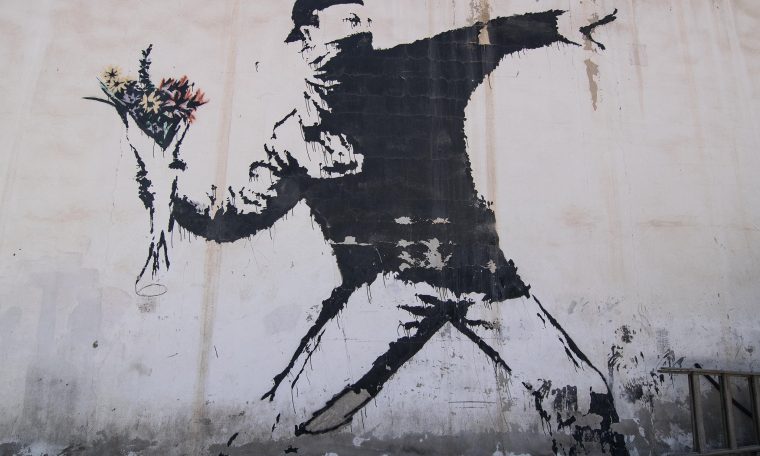The famously anonymous street artist Banksy has lost a legal challenge concerning one of his best-known works, “Love is in the Air”, also known as “The Flower Thrower”. Full Colour Black, a UK greetings card business, successfully contested Bansky’s application to register the painting as a trade mark, in a case which neatly highlights the differences between trade mark rights and copyright.
Moulis Legal’s Shaun Creighton and Graeme Fearon examine some of the legal issues behind this decision.
Know your IP rights
Copyrights are automatically created whenever an original work is recorded in some permanent form. Usually this would involve writing an original novel or recording an original song etc., but it’s also clear that spray-painting a design on a wall in Bethlehem will suffice! Copyrights are long lived (typically lasting for 70 years after the creator’s death) and generally serve to protect an artist’s right in their creations. A third party wishing to reproduce or adapt a protected work will need the copyright holder’s permission to do so.
Trade marks on the other hand are a means for a business to protect its identity or brand as a means to distinguish itself from its competitors. Unregistered trade mark rights can arise from the minute an enterprise begins to trade with a distinctive get-up, but these rights can be hard to identify and difficult to enforce. Registration helps clarify the situation, allowing for a clear encapsulation of exactly what aspects of a brand are protected and to what extent. Registered trade marks need to be renewed every 10 years, but can, in theory, last in perpetuity. They can be swung into action to prevent a competitor using another identical or confusingly similar trade mark in respect to identical or confusingly similar goods and services.
Although these rights overlap somewhat, the main difference between them is that copyright looks to protect artistic originality, whereas trade marks are more concerned with regulating the use of branding in the marketplace. As a consequence, a trade mark owner will need to demonstrate genuine commercial use of their chosen brand in order to enjoy the benefits which come with registration. To enforce registered trade mark rights, it will be necessary to establish that there was use “as a trade mark”.
Around the world, each individual country will have its own applicable laws but there is significant global harmonisation. For instance, in Australia copyright is covered by the Copyright Act 1968 (Cth) and trade marks are governed by the Trade Marks Act 1995 (Cth) but these are generally similar to UK and European Union law which applied in Banksy’s case. This story therefore has a wider international relevance and should serve as a warning and lesson to other artists and businesses in multiple jurisdictions.
“Copyright is for losers” – and so, apparently, are trade marks!
Where Banksy tripped up was in trying to use trade mark rights to do the job of copyright.
While he would almost certainly have been able to enforce his copyright in “Love is in the Air”, he might have had to give evidence in person to explain how and when it was first created. This would have put his prized anonymity at risk (as well as clashing with his professed view that “copyright is for losers”!) and so he seems to have preferred not to take this option. This isn’t to say that an anonymous or pseudonymous individual can’t own or assert copyright, but it makes the job much more complicated. As an alternative, Banksy might have considered assigning his copyrights to his management company, Pest Control Ltd, so that the company could effectively enforce the intellectual property on his behalf. However, the risk of him having to explain matters in person still appears to have been too great. The other option Banksy could have taken is to recreate similar artwork as an employee of his management company, and leave it to the executives of his management company to prosecute any copyright matters.
Trade mark registration, by comparison, is a much more procedural affair and only requires forms to be filled out and submitted, all of which can be done electronically. However, a valid registration is dependent on the trade mark in question actually being used, and “as a trade mark”. If it can be shown that no use has been made of the mark in the last 5 years, or that there was never a bona fide intention to use the mark, the registration can be invalidated. Furthermore, in Australia, it is implied that an applicant will use their trade mark. Since intention of use is merely implied at application stage in Australia, it then becomes a ground of opposition at Australian trade mark law, namely that the applicant did not intend to use the trade mark.
Banksy’s trade mark application was submitted in 2014 but the trade mark was not used on any goods or services until 2019. An attempt by Banksy to set up a shop in London selling goods bearing his artworks was held to be a legal tactic rather than a genuine commercial outlet for merchandise, as well as coming too late in the day to help his case.
Full Colour Black successfully argued that Banksy had shown “bad faith” in his trade mark dealings, and this was ultimately what won the case for them. “Bad faith” can arise where an applicant has no genuine intention to use a particular trade mark but is nevertheless seeking to block it out in order to obstruct competitors.
There could also have been an argument that “Love is in the Air” was not actually being used as a trade mark (i.e., a form of branding) but rather as decoration on a product. In other words, a consumer would not think the artwork was there to say, “this is a genuine Banksy product”, but simply, “this is a product with a Banksy artwork on it”. A product containing Banksy artwork, as was the case here, would more likely amount to use of copyright rather than use as a trade mark.
“Nothing has the right to exist unless it makes a profit”
If Banksy wishes to commercialise intellectual property rights in his artwork, he needs to rely on established intellectual property laws. Banksy could presumably benefit from licensing his copyright if prepared to identify himself (or re-structure his arrangements). He could also secure trade mark rights for certain brands including, for example, a brand “Banksy” to indicate the source of the artwork, which would be consistent with the role of trade marks to act as a badge of origin.
The outcome of the current case chimes unfortunately with this rather sardonic quote of his. However, he largely only has himself to blame. Graffiti artists exist in a legal grey area – their work may be undoubtedly creative, but often amounts to criminal damage and the law tends not to look kindly on scofflaws trying to assert their own rights. Having said that, many property owners would be delighted (not to mention significantly enriched) by having a Banksy painted on their premises!
While it does seem that the European Union Intellectual Property Office (EUIPO) took against him on account of his unconventional ways – his anonymity, his apparent disdain for legal matters and his larrikin manner all seemed to count against him – he ultimately lost his case on a straightforward question of trade mark law.
Trade mark rights are inherently mercantile in nature and can only be maintained and enforced in a commercial context. If you’re looking to protect art for art’s sake, you need to be dealing with copyrights. If you are looking to protect a brand, you need to be dealing with trade marks. Although trade marks can protect, for example, character merchandising, it is copyright that protects artwork.
As a result of this decision, Banksy’s other trade mark registrations are now at similar risk of invalidity unless he can begin to demonstrate that he is genuinely using them in a commercial setting. If it seems perverse that a third party can profit from his talents while he himself cannot, this also underlines the stark fact that sometimes artistic principles come with a hefty price tag.
Intellectual property rights such as trade marks and copyrights can seem complicated at first sight and often get confused. However, Australian law is reasonably straightforward and provides businesses and individuals with a comprehensive range of rights and remedies. If you are considering enforcing or challenging any intellectual property rights, it is always prudent to seek the assistance of a specialist intellectual property lawyer.
An artist or creative enterprise protecting, enforcing, and commercialising their valuable intellectual property through established copyright and trade mark laws may well be laughing all the way to the bank. In this case, the last laugh was on Banksy.
This memo presents an overview and commentary of the subject matter. It is not provided in the context of a solicitor-client relationship and no duty of care is assumed or accepted. It does not constitute legal advice.
© Moulis Legal 2020


